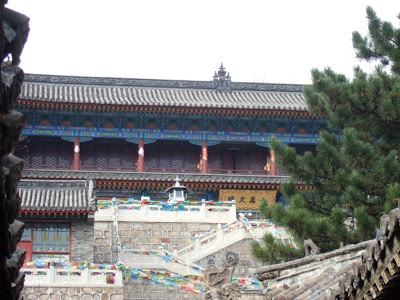

During our stay in Wutaishan, we came twice to visit Temple Bishan-si but unfortunately we did not have the opportunity to go into the site as it was closed both times we were here. The unique about this Monastery is because it is managed by monks who come from all over the places. The management community and abbot are chosen from election among the monks living here under one condition that monks who accommodated here does not allow to have any official disciples. This is to ensure that the temple does not belong to any people but to the community of Sangha who stay here. Such kind of system has made the temple in fame throughout the nation. The practice of Temple is to provide free lodging and food for Sangha who drop by and many times even help them with transportation when they leave. Great masters who came here to give Dharma talk and teach Sutra included Rev. Jinbi-fen of Yuan Dynasty (元朝金壁峰), Meditation Teacher Kuyue of Ming Dynasty (明朝古月禅师), and great masters Rev.Xuyun, Rev. Yinguang, Rev. Yuanyin from early 20th century (虚云,印光和圆瑛大师). Bishan-si was first established in Northern Wei Dynasty (386-557) but restored during Ming Dynasty. Bishan Puji Zen Temple of Ten Directions (碧山十方普济禅寺) is the full name of the temple. Originally it was called Puji-si (普济寺) and also known as Beishan-si (北山寺)and Bishan-si as it lies at the foot of Peak Yedoufei of North Plateau (北台叶斗峰) and nested in a green environment. The heritage of its extraordinary Precept Hall (戒坛) built in Northern Wei period, was the only one remains in Wutaishan. The other two treasures are a Buddha Image made from Myanmar white jade and the 600,043 characters pagoda of Avatamsaka Sutra (华严经字塔) which was now preserved in the Library of Xiangtong-si. The product was written with Chinese ink brush at a size as small as a mung bean by Mr. Xu-dexing (许德兴). who used 12 years to complete this piece of Buddhist Art.


The scenic sight of Yedou-feng ranges of North Plateau (北台叶斗峰).



Temple Bishan-si was nested in the valley of mountain ranges.


There are a few Temples and nunneries located at the slope of these beautiful mountain ranges and along the road heading towards East Plateau.


The Temple of Qifo-si (七佛寺), located on a hill slope at village DongZuang-cun (东庄村) has the tallest white marble pagoda in Wutaishan. The 7 layers Pagoda is built on a stone base in hexagon shape with a height of 22 meters. Each layer has a decorated window enshrined with images of 1 present and 6 past Buddha (毗婆尸佛,尸弃佛,毗舍婆佛,拘留孙佛,拘那舍佛,迦叶佛和释迦摩尼佛) The present Buddha Sakyamuni was at the top layer. Temple of the Seven Buddha was first established in Northern Song dynasty (960-1127) and restored during Ming Dynasty in year 1466. During the reign of Emperor Yongzhen (1722-1735) in Qing dynasty, it was rebuilt by the Lama from Pusa-Ding and converted into a Yellow Sect Tibetan Temple. Presently it should be a nunnery of Mahayana Buddhism.



Many places of Qifo-si was closed for renovation when we were there. While wondering where to begin our visit, an elderly nun approached me, holding my hands and talked to me very kindly as if she had missed me for long. She brought me to a small hall where a very old ancient image of Bodhisattva Manjushri is enshrined at a side altar. She said this is a treasure to the temple. She requested me to bow to the ancient Bodhisattva with full sincerity. I did as she said and each time my forehead touched the ground, I heard she strike the singing bowl and murmured lots of blessings for me and my family. While taking me around other halls, she told me that going to a temple, faith and sincerity are most important, as far as contribution concerned do within the limit when you are traveling as each hall in a temple site has a donation box. Before leaving, she hold my hands tight saying that we may have a deep affinity in the past life. My eyes were wet with tears. The care and warmth given to me while I was far from home, by an elderly nun whom I never met before, touched my soul.



The Temple is famous for enshrining the past seven white jade Buddha images from Myanmar in its West Hall. The figures look adorable and elegant. The three Buddha images in East Hall are gilded with gold like most that appear in the main Shrine Hall of many Mahayana Chinese Temple .


The beautiful Murals.


The Huge screen wall inscribed with Heart Sutra on one side and the name of the temple on the reverse side is erected high on the slope in front of the main halls at Temple Jifu-si (集福寺).

Temple Jifu-si also known as Hongquan-si (洪泉寺), was built in year 1773 in Qing Dynasty. It was originally established into a Lama Temple with 80 over structures over its 6300 sq. meter of land. The structure display a typical style of Tibetan Monastery.


The old structures of 9 shrine halls, one bell and one drum tower plus two stone sutra pillars still remain at the site.


Temple Jifu-si now is a nunnery. The three main buildings of Lokapala Hall, Manjushri Hall and Grand Shrine Hall are standing along the axis line with veranda, all are in rectangular shape.


To many's surprise, a statue of Song famous patriotic general Yang-Wulang (杨五郎) was housed in the west hall behind the main building. General Yang became a monk after he was framed by internal members and lost the battle to the northern invaders. He was reputed and gained respect by many locals as when the country faced another attack, he lead the 500 monks who had long time under his daily training and successfully protected the country being defeated.


No comments:
Post a Comment